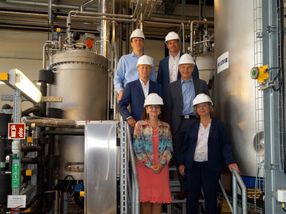Wacker and Bader Receive CO2 Efficiency Award for Leather Polymer Composites
Advertisement
Along with its partner Bader GmbH & Co. KG, the Munich-based Wacker Group has won the MATERIALICA Design + Technology Award in the CO2 Efficiency category for its leather polymer composites (LPC). The award was presented in Munich at MATERIALICA, the international trade show for materials applications, surface technology, and product engineering. Innovative composite materials made of VINNEX® binding powders and recycled scrap leather make it possible to manufacture completely novel design products for the flooring, interior-finishing, and furniture industries. Using scraps from leather processing, the new material is exceptionally resource-efficient and may reduce CO2 emissions by up to 30 percent.
For eight years now, MunichExpo Veranstaltungs GmbH has been presenting the MATERIALICA Design + Technology Award to acknowledge innovative materials which provide functional, aesthetic, and production-related inspiration. Winners are selected in four categories: Materials, Products, Surfaces & Technologies, and CO2 Efficiency. In this last category, the emphasis is placed on aspects such as using less material and energy during manufacturing or processing as well as the sustainable use of raw materials, recycling, and streamlining of production.
In these regards, the cutting-edge leather polymer composites developed by Wacker and its partner company, Bader, convinced completely. This new material is based on the product platform of natural fiber composites (NFCs): composite materials made of natural products such as cork, wood or leather, and specialty powder binders containing vinyl acetate and ethylene (VAE) copolymers. Thanks to this new technology and VINNEX® powder binder, scraps from leather processing can be transformed into versatile new materials. To this end, the cutting waste from the leather industry is compressed to pellets and processed with VINNEX® to yield leather sheeting. This regenerated leather can be used, for example, to make durable flooring tiles and coverings for automotive interiors, furniture or walls. Depending on market requirements, various coating systems and patterns can also be applied during further processing.
Key features of the new leather polymer composites include recyclability, value-added marketing of scrap materials, and energy-efficient thermoplastic processing. This product is made of recycled scraps from leather processing and thus facilitates the conservation of resources and efficient use of raw materials. In addition, Wacker estimates that this technology reduces CO2 emissions by as much as 30 percent. By recycling renewable resources, Wacker is further fueling the trend toward sustainable development.
Most read news
Other news from the department research and development

Get the chemical industry in your inbox
By submitting this form you agree that LUMITOS AG will send you the newsletter(s) selected above by email. Your data will not be passed on to third parties. Your data will be stored and processed in accordance with our data protection regulations. LUMITOS may contact you by email for the purpose of advertising or market and opinion surveys. You can revoke your consent at any time without giving reasons to LUMITOS AG, Ernst-Augustin-Str. 2, 12489 Berlin, Germany or by e-mail at revoke@lumitos.com with effect for the future. In addition, each email contains a link to unsubscribe from the corresponding newsletter.



























































